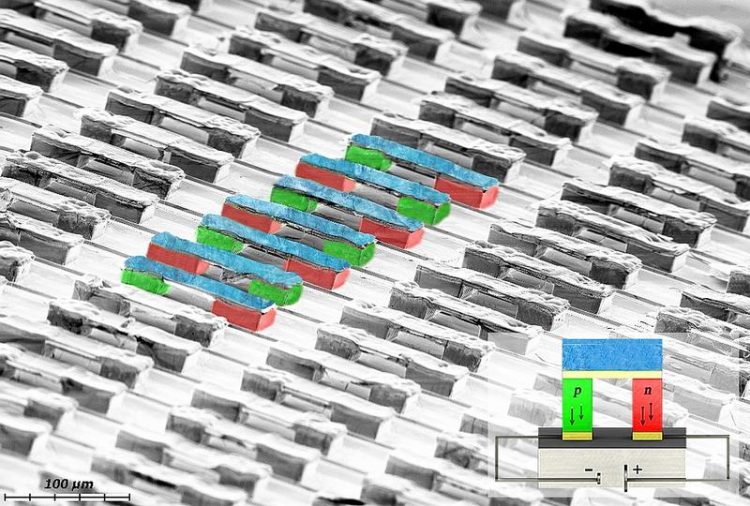Thermoelectric cooling gets fit for micro technology

Array of micro-thermoelectric devices with a packing density of about 5,000 pieces per square centimeter. The free-standing design reduces thermo-mechanical stress.
Thermoelectric materials can convert heat into electricity or, vice versa, can be used as environmentally friendly cooling elements.
In many processes in everyday life and in industry, energy losses occur in form of waste heat, which can be converted by thermoelectric generators into electrical energy. This also provides an additional power source in these systems.
Another particularly attractive application of thermoelectric materials is the cooling of microelectronic components, for example in processors or for thermal management in organ implants. For this purpose, thermoelectric generators must be suitable for integration into modern microelectronic systems.
In addition, the manufacturing process must be compatible into the established processes of chip production. All this has proven challenging, so that a broad application of micro thermoelectric devices has not been realized so far.
Now there is a promising new approach by researchers at the Leibniz Institute for Solid State and Materials Research Dresden (IFW). They introduced a crucial innovation in the deposition process of the thermoelectric bismuth tellurium compound.
An additional gold electrolyte bath immediately after the layer deposition forms a protective gold layer on the thermoelectric elements. This interface significantly reduces the resistance between the thermoelectric material and the contact layer, which has a very positive effect on the efficiency and the functional stability in the long-term test.
The micro-thermoelectric devices processed in this way offer a very fast cooling response times of only one millisecond and a high reliability of more than 10 million cycles and more than 30 days of stable cooling performance. The improvement of these figures represents a decisive step towards the broad application of thermoelectric components.
Dr. Gabi Schierning
g.schierning@ifw-dresden.de
IFW Dresden
Phone: +49 (0) 351 4659 1875
Guodong Li, Javier Garcia Fernandez, David Alberto Lara Ramos, Vida Barati, Nicolás Pérez, Ivan Soldatov, Heiko Reith, Gabi Schierning & Kornelius Nielsch. Integrated micro thermoelectric coolers with rapid response time and high device reliability, Nature Electronics, volume 1 (2018) https://doi.org/10.1038/s41928-018-0148-3
Media Contact
More Information:
http://www.ifw-dresden.deAll latest news from the category: Materials Sciences
Materials management deals with the research, development, manufacturing and processing of raw and industrial materials. Key aspects here are biological and medical issues, which play an increasingly important role in this field.
innovations-report offers in-depth articles related to the development and application of materials and the structure and properties of new materials.
Newest articles

Economies take off with new airports
A global study by an SUTD researcher in collaboration with scientists from Japan explores the economic benefits of airport investment in emerging economies using nighttime satellite imagery. Be it for…

CAR T–cell immunotherapy targets
Pan-cancer analysis uncovers a new class of promising CAR T–cell immunotherapy targets. Scientists at St. Jude Children’s Research Hospital found 156 potential CAR targets across the brain and solid tumors,…

Stony coral tissue loss disease
… is shifting the ecological balance of Caribbean reefs. The outbreak of a deadly disease called stony coral tissue loss disease is destroying susceptible species of coral in the Caribbean…





















